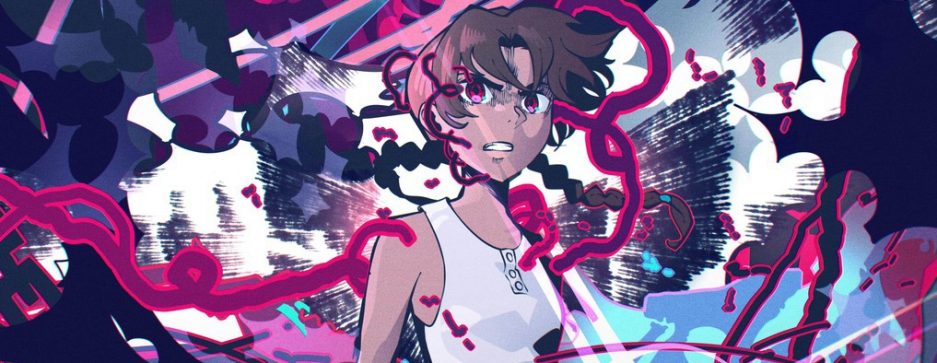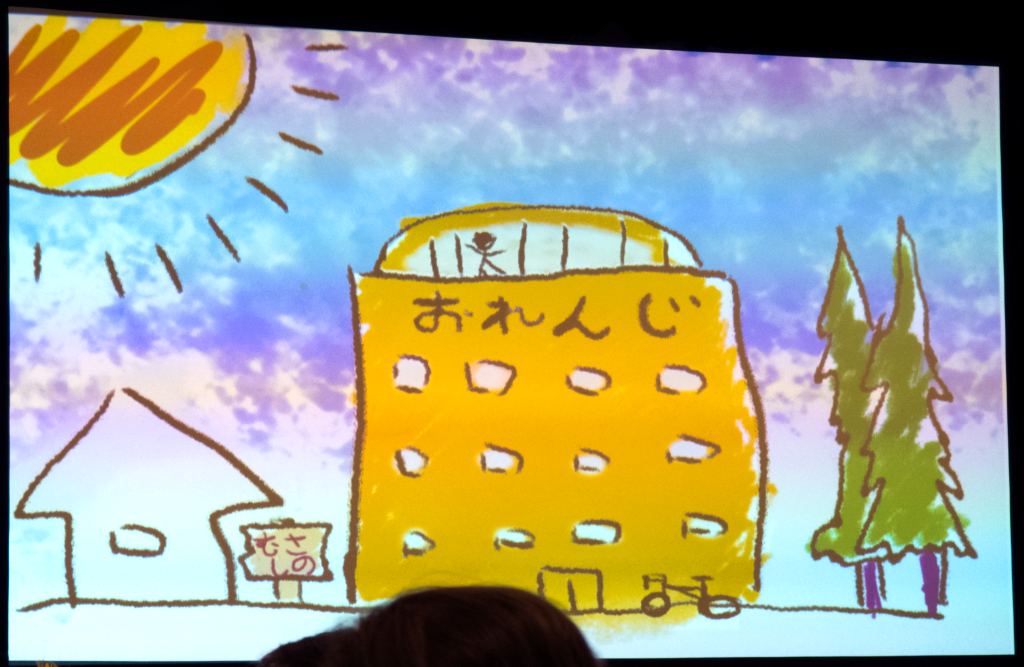
Orange producer Yoshihiro Watanabe organized his Sunday roundtable at Otakon 2023 with CG Director Shingo Kiyomiya and CG Producer Kiyotaka Waki to be a genuine discussion – a dialog to better understand each others’ duties and perspectives. The structure was simple: Watanabe would frame his topic of discussion as a question, and they’d all weigh in.
First though, they introduced the studio and some of their work. Orange, founded by Eiji Inomoto in May 2004, is now 19 years old. However, Orange is going by “years of operation,” so they count 2004 as “year one” and consider 2023 to be their 20th year making anime. Either way, they’ve come a long way in the past ~two decades. In 2013, they employed 37 people. Now they employ around 140 in a four story studio plus basement. If I recall, the basement is where they have most of their motion capture gear set up, which I have to imagine helps with the banging around. It sounds like a very nice studio by all accounts, but lately they say it’s been getting crowded and they’re looking to expand.
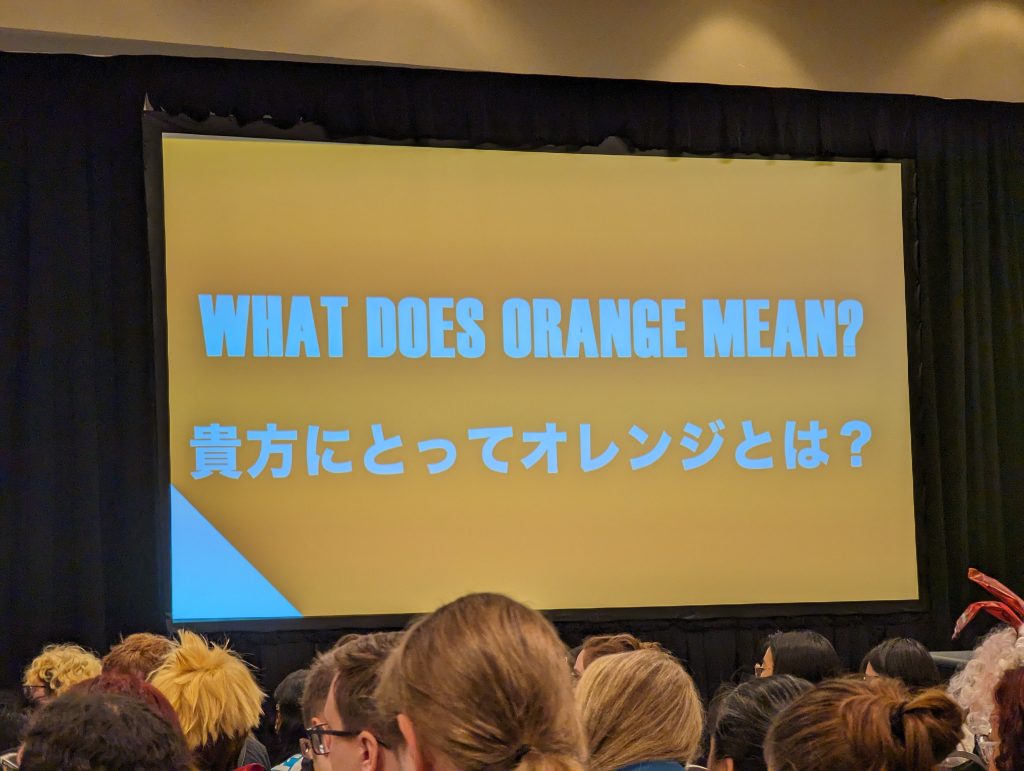
After these opening remarks, they muse a bit on their personal histories. Waki was the one who beckoned Watanabe to join Orange a few years back, telling him that it was “a pleasant place where you can do CG.” Watanabe was incredulous. Both of them are Madhouse alumni: a studio which under Masao Maruyama pushed the cutting edge and gave some of the most interesting figures in the industry a chance to shine, but the name is frankly apt. Despite some truly noble intentions, there are few studios in the industry which can legitimately claim to be a pleasant place to do anything, and perhaps only one other which can also claim to be exploring any artistic frontiers. These two know better than most how goddamn hard it is to follow up on the promise of making anime on one’s own terms. That’s why Watanabe continues to be incredulous, and continues looking for ways to improve the studio. “These guys are saying such nice things about Orange, but I want to dig deeper into its intestine.”
It wasn’t just Orange that Waki and Kiyomiya had kind words for, but Watanabe himself. “[Watanabe is] a very strange person, and not the sort of person you’d normally find in this profession,” Waki said. Watanabe replied that he’s not the only weirdo at Orange. Around two decades ago, nobody believed in President Inomoto’s vision, and he got “kinda kicked out of the 3DCG industry.” Inomoto apparently continues to check every single shot in Orange’s productions. Kiyomiya had no experience with CG before joining Orange, but was able to learn. Orange is “like a school,” and under Inomoto the company has grown. I should mention here that while as far as I’m aware Orange has no formal education program, they’ve made pretty serious investments in tools to make sure that all their know-how gets passed along as employees come and go.
As for why they make anime, they all have a broadly similar but importantly different perspective. Watanabe talked about how growing up in America, anime was something which made him feel less estranged from Japanese culture at first, but now he sees it as a way of bridging communities. Many different people watch the same anime, and even if they come at it from different places, they’re able to have a conversation about it. Kiyomiya says that every anime impacts you in some way, and he was fascinated when he was younger by the fact that people made this stuff. He wants to impact other peoples’ lives the same way as they have impacted his own. Waki agrees, but especially with regards to mecha anime. Mecha anime rules.
Next, Watanabe asks his coworkers: “what is quality animation?”
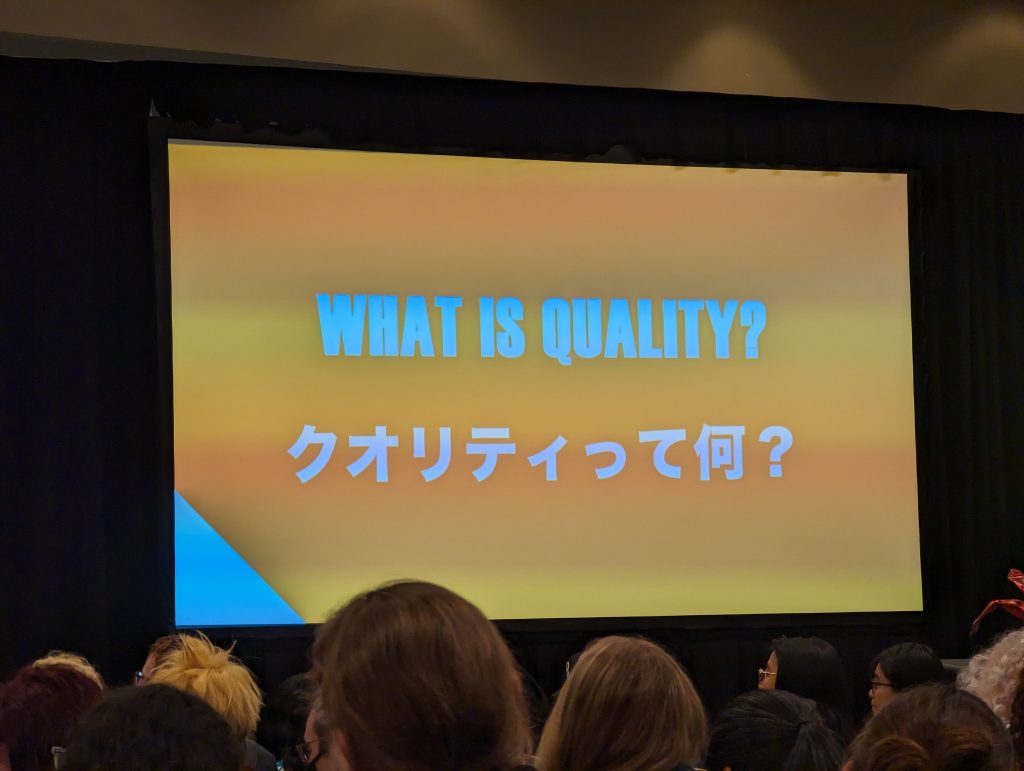
-a question that had English-speaking anime otaku of a certain generation snickering, but a good one.
Waki defines quality in terms of satisfaction: quality animation is animation that does not pass through his team’s hands until they’re satisfied with it. As such he believes that the bar for what he should be satisfied with should be higher for each project he works on. He feels that if it isn’t, then “things will not turn out very well.” This hints at a second, secret criterion: what is the thing that won’t turn out very well? My impression is that Waki and Orange’s satisfaction is defined differently from project to project. For instance, they felt with Trigun Stampede that nailing the feel of the human (or at any rate humanoid) characters was absolutely vital – so vital that Watanabe characterized Land of the Lustrous and Beastars as training for this very project. (Note: in the sense that they learned valuable lessons on those projects, not that your blorbos are “mere training” to them, please stop spamming Watanabe for info about the Beastars final season)
It shouldn’t be surprising then that Kiyomiya wants to stress that “quality” doesn’t mean “flashy action sequences.” He feels the way that they express characters through movement is very important. A thousand little things like how a character smiles or tilts their head add up to give them a sense of life. Putting in the work and thinking through those details is what he feels gives his own work quality.
Watanabe turns the question 90 degrees: just because the animators have made something they feel is quality – that satisfies them – doesn’t mean that the outside world will understand. Even if a viewer agrees that a piece of animation is “quality,” that sense of satisfaction may be completely unintelligible to someone who didn’t directly work on the project. Of course, none of that matters if nobody knows about the anime in the first place. Watanabe feels that many great accomplishments at Madhouse are still unsung for that very reason. That’s why one of his main goals is to figure out how to release information such that people not only learn about the show and get excited for it, but also so that they understand what exactly they’re watching.
On the one hand, it’s called “marketing.”
On the other: same.
Since they’re already on the topic, Watanabe brings the discussion around to personal goals and challenges. To Waki, the challenge isn’t just to improve the quality of his own work like he talked about earlier, but to know where and what to improve. That’s not easy. He reflects on that a lot, and bounces his reflections off President Inomoto.
Watanabe observes that constantly striving takes a lot of energy, and even stress. Kiyomiya agrees, but believes that without the stress inherent to that kind of striving, there can be no growth. No pain, no gain. Nonetheless, Watanabe feels that if he’s going to take on that kind of stress, it’s important for him to be able to unwind as well. He elaborated a bit on Orange’s policies regarding hours and recreation at last year’s panel, but I don’t want to misrepresent his claims, nor regrettably do I have any contacts at Orange to validate them. Suffice it to say, they seem to take the challenge of not burning themselves out seriously.
On the other hand, he feels it’s important that new hires understand what they’re getting into. Showing exactly what it’s like to work at the studio to a prospective employee in a brief tour is difficult. For his part, Kiyomiya says that the newcomers he takes care of at the studio all come with plenty of resolve. What he tries the most to impart to those new employees is that they should aim to “finish what they start” – to encourage them to push themselves however they can so long as they finish within the time given to them.
Next, Watanabe turns the discussion towards the future.
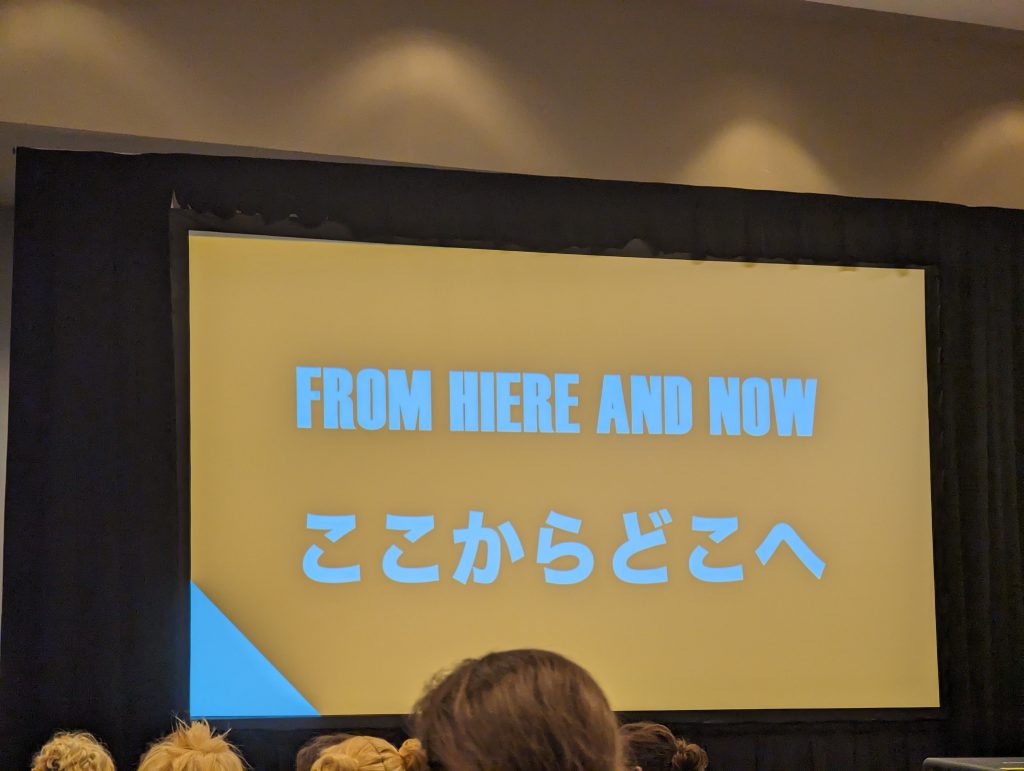
As he already mentioned, when Waki joined Orange during production of Land of the Lustrous, he had no experience with CG animation. It was a totally unknown challenge, but it was the right direction. He feels Orange’s strength as a studio is being able to seize upon unforeseen opportunities like that and execute on them – “challenging the unknown.” Whatever Orange’s future is, that’ll be what shapes it.
Watanabe’s outlook is a bit different. He’s been a part of Orange since Beastars, and the one thing that’s impressed him is that despite everything, they’re still limited in what they can achieve by money, time, and even technology. Providing these things has been his main goal as a producer. He says he can’t imagine what they’d be able to create if only they had more of those things. It should be said that Orange has been quite fortunate on all of those fronts – or rather, that Watanabe and his fellow producers have been quite successful – and this is partly why they’ve been able to do what they’ve done both artistically and as an institution.
Waki reframes the discussion a bit. He feels that Orange as it exists is tightly bound to President Inomoto himself: not just his vision, but him personally as an animator due to how deeply involved he is with production. He sees Orange’s future as not “moving away” from Inomoto so much as being more independent of him, so that “he doesn’t have to check every single thing” and they can take on a wider variety of projects. Indeed, Kiyomiya calls Inomoto a man “from another dimension” – a “Super Animator.” It takes Inomoto 20 minutes to do something that would take Kiyomiya half a day. He says Orange is already working on projects where Inomoto isn’t expected to be involved, so if that is indeed the future, the future is pretty near.
Watanabe again turns the discussion back to Kiyomiya and Waki. Since Waki and Watanabe are producers, they’re not deeply involved in the everyday concerns of the production process, and the inverse goes for Kiyomiya as an animator. He asks if there’s anything they’d like to ask each other about their own jobs. Kiyomiya goes first: producers attend production meetings where they’ll sometimes make this or that request, so what goes on ahead of the meeting in preparation? Waki answers that much of the five years spent planning Trigun Stampede were spent “planting seeds,” and that much of their job involves “planting seeds” for future projects. Beastars had been in discussion since February 2017, and Godzilla: Singular Point since 2016. He doesn’t elaborate on exactly what this means, but I assume between the seeds and the interdimensional super animators we should expect a bunch of generation ships to start falling from the skies any day now. The point is that from the producer’s point of view, setting the ideal conditions for a project takes a long time.
On the other hand, Waki wants to know how the younger animators feel about Inomoto. Do they want to be super animators like him? Do they want to be directors? Do they have completely different goals? In short: how is the culture among the newer generation evolving? Kiyomiya replies that he and his own team are very much inspired by Inomoto and fall into that former camp. The big generational divide is between those who came before Land of the Lustrous, and those who came after. Those from before knew Orange as a “mecha studio.” That’s what they signed up for. With Land of the Lustrous, Beastars, and now Trigun Stampede, a lot of their energy goes into animating human characters. Kiyomiya and many from his generation did come to appreciate the finer points of character animation, and there are more and more people at the studio who share that fascination.
Waki follows up: what exactly is the difficult part of animating human characters in everyday scenes? Kiyomiya says it’s the small nuances he talked about before, but also that it requires a deep understanding of how the human body works. When you raise your hand, your shoulder moves too. If you animate someone turning around and don’t have their head turning ahead of their torso, it looks wrong because that’s not how people actually move. It’s taken many years for them to get where they are today: not only learning these things through trial and error, but figuring out how most effectively to apply those lessons. Action animation is almost an entirely different skill, he says. With action, your main concerns are the poses, the shot composition, and the camera movement.
At this point, they open up the floor to audience questions. I’ll go through these in bullet list form.
- An audience member asks what the hardest part of a character to rig is, but that got a bit lost in translation. To Kiyomiya, the hardest challenges in character animation have to do with when a character’s outward expression doesn’t match what they’re feeling – for instance, a forced smile.
- Production for IDOLiSH 7 LIVE 4bit BEYOND THE PERiOD – a fictional Idolish 7 concert – was very different from their normal TV and film productions. For one, they made it in Unreal Engine instead of their usual software. Moreover, it all takes place in the same environment using the same characters.
- A game animator asks Kiyomiya whether they block out animation using stepped keys or spline. Roughly speaking, the question is about whether when figuring out their keyframes, they let the computer generate inbetweens or not. As someone who doesn’t know as much about 3D animation, this is super interesting to me. They also ask if they incorporate Blender 3D into their workflow. Unfortunately, it got lost in translation again. After a bit of clarification, Kiyomiya did answer that they use a lot of spline, but didn’t elaborate when in the process or how.
- Another animator from the same studio asks how they distort the faces based on camera angle: do they use shape keys, or do they use bones? The bone part got lost in translation and the question Kiyomiya ultimately got asked was “shape keys or blend shapes” (they’re the same thing), but Kiyomiya did confirm that they use shape keys for the deformation.
- Understandably they look back on old projects like Land of the Lustrous and think about all the things they could’ve done differently, and apply those ideas to their current and future projects.
- Kiyomiya’s favorite HnK gem is Amethyst, and the most difficult to animate was Phos.
Watanabe hosted two panels with Kiyomiya and Waki at Otakon this year. The first was on Saturday, where they shared production materials for Trigun Stampede. The event packed the main ballroom and brought back images of the early 2000s. I was at Trigger’s press conference and missed the first half hour, but Evan Minto liveblogged it. Some of those character sketches are real neat, and it’s always nice to hear how much highly methodical clowning around in office chairs goes into mocap for character animation. However, there’s one thing that caught my attention that Evan didn’t mention: their “storyboards.” It’s time to talk about ambiguous anime production terminology that English-speaking sakuga fans mostly haven’t had a reason to use!
Now, if you’re familiar with anime production, you’ll realize immediately that this is not anything like a typical anime “storyboard.” The proper term for what we’re looking at is「コンテ撮」– “konte satsu” – which I might translate as “boards shot.” This consists of taking elements from the storyboard and turning them into video using the timings specified in (typically) the right column. When voice actors or other staff say that production was so behind that they had to dub an episode from “animatics” or “storyboards,” this is often what they mean. Just as you’d expect, you can see that Orange labeled this render internally as

…「タイミング撮」– “timing satsu?”
Traditionally, timing satsu refers to a video of the finished, colored animation before photography or compositing with the backgrounds. A good example is this scene from Shin Evangelion. The part from ~15 seconds is the timing satsu, followed by douga satsu (equivalent to the traditional western concept of a “pencil test”), then genga satsu. We don’t get all the way to konte satsu, but if you search most big studio twitters for「コンテ撮」you’ll find plenty of examples. Here’s one from Kabukichou Sherlock posted by Production IG. You’ll see that the konte satsu is pretty much the same sort of thing as for Orange. You’ll also see that their “timing satsu” includes finished backgrounds – it’s basically everything but the Adobe After Effects pass before being sent on to editing. This isn’t an unusual use of the word either – here’s a “timing satsu” from the wonderful Massara music video directed by KyoAni alum Keita Nagahara. This is because anime production terms are made up and fake.
-or at least so outdated that they no longer mean the same thing. “Timing” probably first referred to “color timing.” The usage was never actually accurate (actual color timing is way upstream of this), but the point of the footage was for checking the colors. That’s still its purpose today – except that in the digital era, this check usually takes place with backgrounds – either partial or finished – already inserted.
So what’s going on with Orange’s “timing satsu?” Frankly I’m not sure. It does look like there’s something about konte satsu down there at the bottom, so maybe it’s just a misleading label. It’s even possible they mentioned some detail that would explain all this and I just didn’t write it down and forgot. Still, I can tell you more or less what it was used for. When you put together footage like this, it’s usually to aid in timing audio to visuals. To that point, you can see markers for “SE” near the beginning and at the end. I’m guessing that Orange starts dubbing way earlier than a 2D anime production so that they can match the lip flaps and character animation to the performance. I invite anyone with deeper knowledge of how 3DCG production works to let me know if I’m missing something.
In any case, you are now armed with the knowledge to be the most annoying person in the entire world whenever someone shares a video of genga.
《if you enjoyed this post, please consider supporting us on Ko-Fi》
…”hiere”
